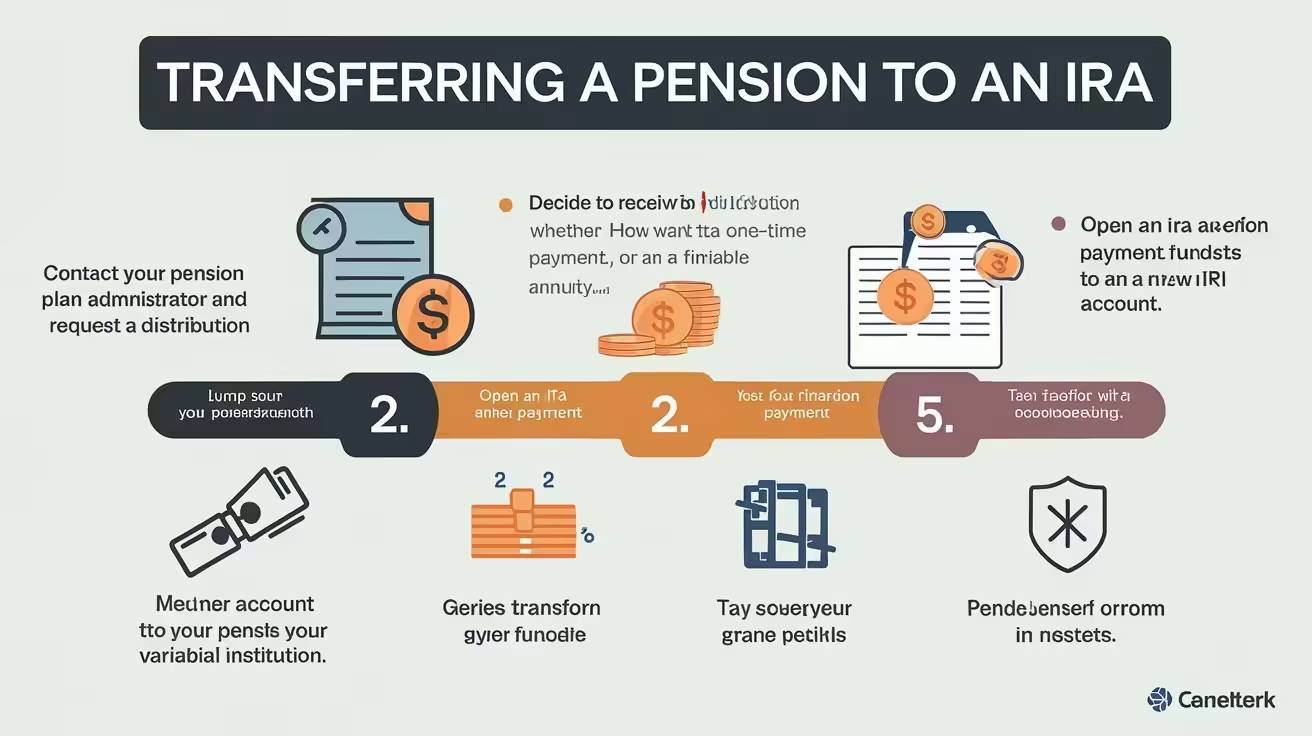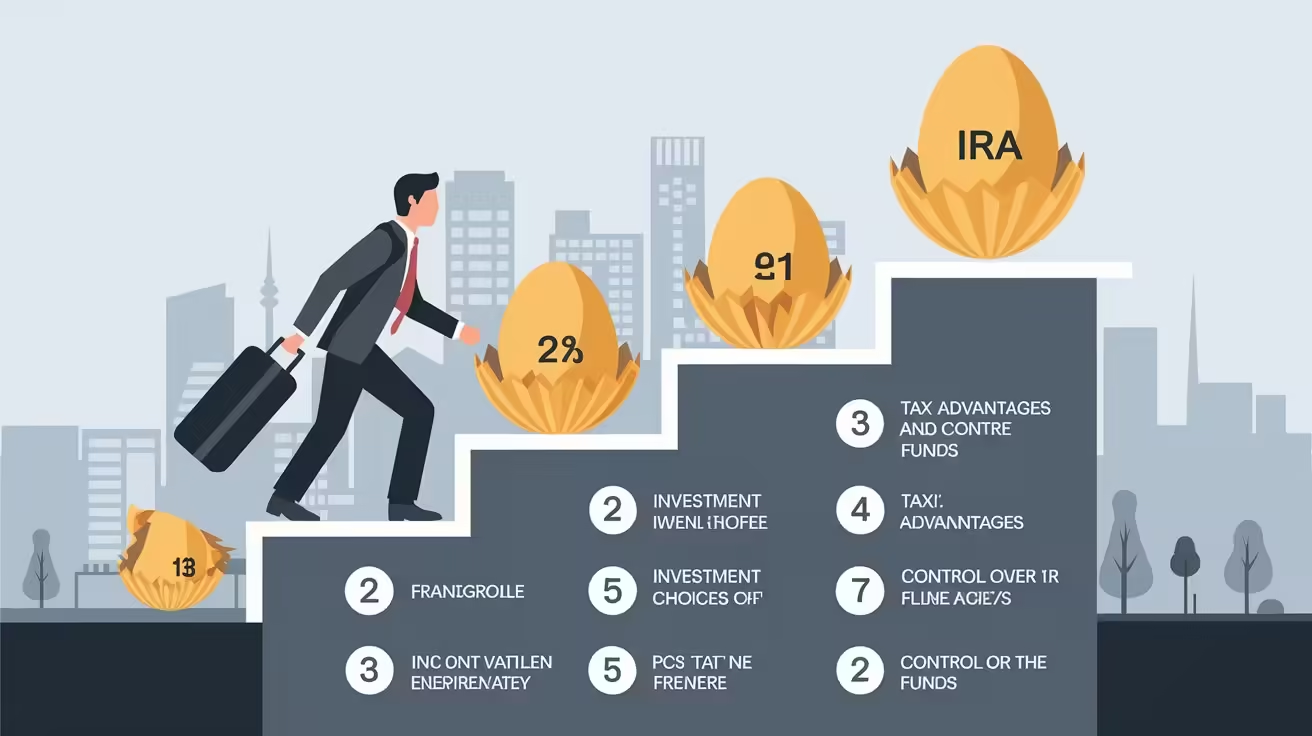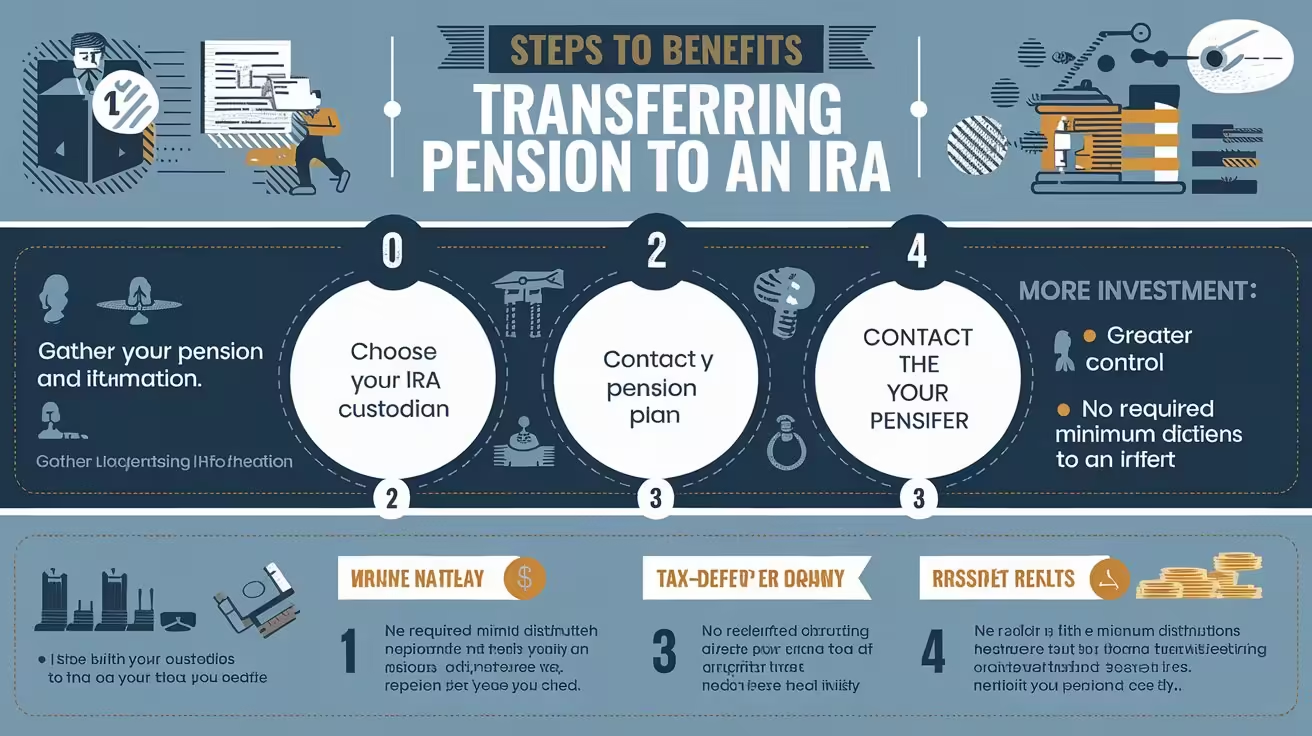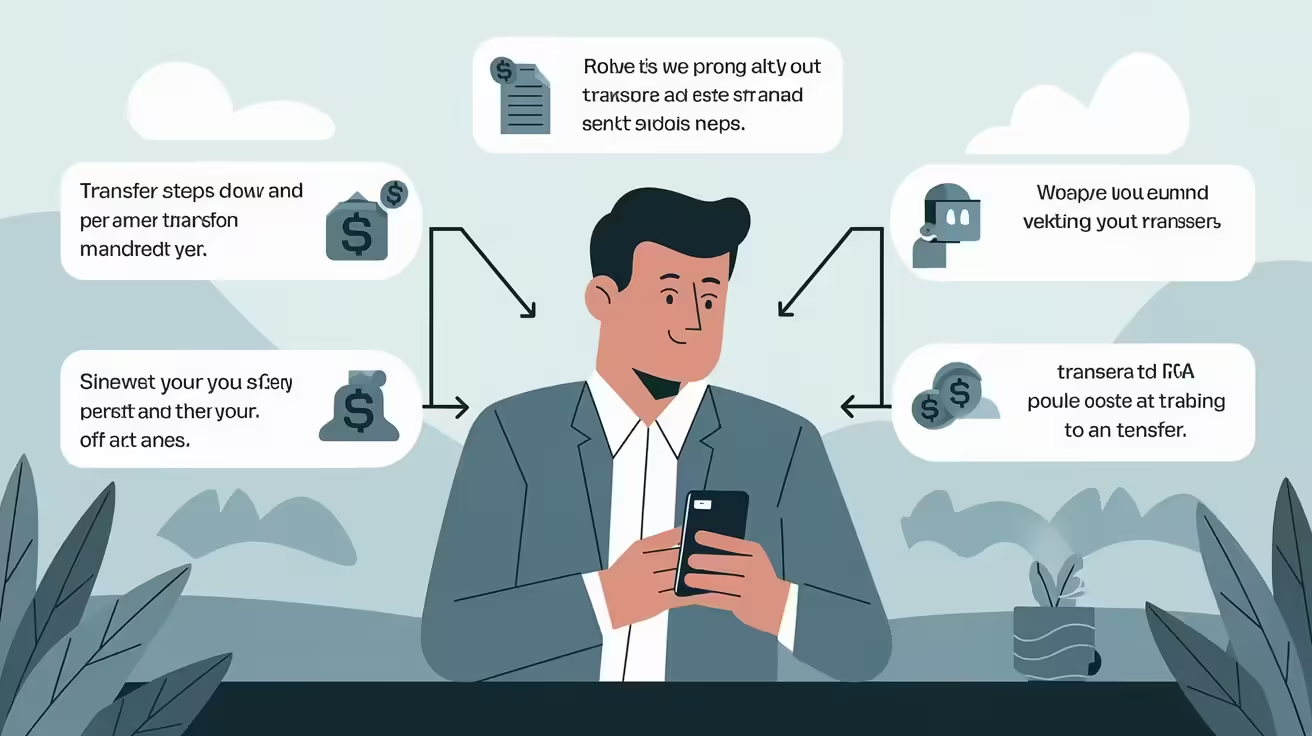Why You Should Consider Transfer Pension to IRA

Retirement planning involves crucial decisions that directly impact your financial stability in the later stages of life. One of the most significant choices you may face is whether to transfer pension to IRA (Individual Retirement Account). For those looking to simplify their retirement assets, gain more investment flexibility, or access broader estate planning options, transferring a pension to an IRA can be an excellent move. However, it is vital to fully understand the process, the advantages, and the potential pitfalls before taking this step.
This article provides a comprehensive guide on how to transfer pension to IRA, the reasons why you should consider it, and the critical factors you must evaluate along the way.
What Is an IRA?
Before delving into the reasons to transfer pension to IRA, it’s essential to understand what an IRA is and the benefits it provides. An IRA is a type of retirement savings account that offers tax advantages to individuals. Unlike a pension plan, an IRA allows you to choose where to invest your funds, offering much more flexibility.
There are two main types of IRAs:
- Traditional IRA: Contributions are often tax-deductible, and the funds grow tax-deferred until you start withdrawing them during retirement.
- Roth IRA: Contributions are made with after-tax income, and withdrawals in retirement are tax-free.
By transferring your pension to an IRA, you gain more control over your investments, allowing you to take charge of your retirement strategy.
Why Transfer Pension to IRA?
There are multiple reasons why individuals choose to transfer pension to IRA. Whether you’re nearing retirement or in the middle of your career, this decision can significantly influence your financial future.
More Investment Choices
Pension plans typically offer a narrow range of investment options, often managed by your employer or a third-party institution. When you transfer pension to IRA, you open up a broader range of investment choices, including stocks, bonds, mutual funds, ETFs, and real estate.
Consolidate Retirement Accounts
If you’ve had multiple jobs over your career, you may have several different retirement accounts. By transferring your pension to an IRA, you can consolidate these into one account, simplifying your finances and making it easier to manage your retirement savings.
Control Over Withdrawals
One of the significant benefits of transferring to an IRA is having more control over your withdrawals. With a pension, you’re often locked into fixed monthly payments, but with an IRA, you can decide how much and when to withdraw, allowing for more financial flexibility in retirement.
Estate Planning Flexibility
IRAs also offer more options for estate planning compared to pensions. In many pension plans, the money may stop once you and your spouse pass away. However, with an IRA, you can designate multiple beneficiaries, ensuring that your assets can be passed down to future generations.

How to Transfer Pension to IRA: A Step-by-Step Guide
Understanding the proper steps to transfer pension to IRA is essential to avoid penalties and tax liabilities. Here’s a detailed guide to ensure the process is smooth and beneficial.
Step 1: Review Your Pension Plan
The first step is to review the terms of your current pension plan. Some pensions may not allow for a transfer to an IRA, while others may have specific conditions attached. It’s important to check with your employer or plan administrator about the rules for transferring your pension.
Step 2: Speak with a Financial Advisor
Given the complexity of transferring retirement funds, it’s crucial to consult a financial advisor before making any decisions. They can provide valuable insights into whether a pension-to-IRA transfer is the best option for you, help you understand the tax implications, and ensure that the process is done in the most beneficial way.
Step 3: Open an IRA
If you don’t already have an IRA, you’ll need to open one. Depending on your financial goals, you can choose between a Traditional IRA and a Roth IRA. A Traditional IRA is often better for those looking to defer taxes until retirement, while a Roth IRA offers tax-free withdrawals in the future. Be sure to pick a reputable financial institution that offers a variety of investment options.
Step 4: Initiate a Direct Rollover
A direct rollover is the recommended method for transferring your pension to an IRA. With a direct rollover, your pension plan administrator transfers the funds directly to your IRA provider. This helps you avoid taxes and penalties that could occur if the funds were distributed to you personally.
Step 5: Select Investments for Your IRA
Once the transfer is complete, the next step is to select the investments for your IRA. You now have the freedom to choose from a wide array of assets, depending on your risk tolerance and retirement timeline. A diversified portfolio is generally advisable to minimize risk while maximizing returns.
Tax Implications of Transferring a Pension to an IRA
When you transfer pension to IRA, one of the most critical considerations is the tax impact. Fortunately, a direct rollover of your pension to a Traditional IRA can help avoid immediate tax liabilities.
- Traditional IRA Rollover: With a Traditional IRA, the money is transferred tax-deferred, meaning you won’t pay taxes until you withdraw funds in retirement. These withdrawals will be taxed as ordinary income.
- Roth IRA Conversion: If you transfer your pension to a Roth IRA, you’ll owe taxes on the converted amount in the year of the rollover. However, future withdrawals in retirement will be tax-free, which can be a significant benefit if you expect to be in a higher tax bracket in retirement.
Consulting with a tax professional is strongly recommended to understand how the rollover affects your specific situation, particularly if you’re considering a Roth IRA conversion.
Avoiding Common Mistakes When Transferring Pension to IRA
Transferring a pension to an IRA is an important decision that requires careful planning. Avoid these common mistakes to ensure the process benefits your retirement plan:
Not Using a Direct Rollover
One of the most common mistakes people make when transferring a pension is failing to use a direct rollover. If you take a lump sum distribution and then deposit the money into your IRA, you could be subject to a 20% withholding tax and potential penalties (Transfer pension to IRA).
Ignoring Early Withdrawal Penalties
If you’re younger than 59½, withdrawing funds from your IRA prematurely can result in a 10% early withdrawal penalty, in addition to income taxes. Keep your funds invested until you reach the appropriate age to avoid unnecessary penalties (Transfer pension to IRA).
Overlooking Beneficiary Designations
When setting up your IRA, be sure to properly designate your beneficiaries. This ensures that your retirement funds will be passed on according to your wishes and avoid probate.
Who Should Transfer Pension to IRA?
Deciding whether to transfer pension to IRA depends on various personal factors, such as your financial goals, risk tolerance, and long-term retirement strategy.
Suitable for Those Seeking Flexibility
If you prefer more control over how and when you access your retirement funds, an IRA is a good option. IRAs provide flexibility in both investment choices and withdrawal schedules.
Good for Individuals Focused on Estate Planning
An IRA offers more flexibility for estate planning, as you can leave your IRA to heirs, providing a legacy for future generations. This option makes it appealing for those who want to control how their assets are distributed after death.
Ideal for Those Who Want Diverse Investments
If you’re dissatisfied with the limited investment options in your pension plan, transferring to an IRA allows for greater diversification. You can invest in a wide array of financial products to suit your retirement goals (Transfer pension to IRA).

When Not to Transfer Pension to IRA
While there are many benefits to transferring a pension to an IRA, it’s not always the right choice for everyone. Consider these scenarios where it might make sense to leave your pension as is:
Guaranteed Income Through a Pension
If you value the guaranteed monthly income provided by your pension, it may not be worth the risks of transferring it to an IRA. Pensions offer stability, which can be important for those who prefer a fixed income in retirement.
High Fees or Penalties for Transfer
Some pension plans have significant fees or penalties for transferring funds to an IRA. If the costs outweigh the potential benefits, keeping the pension might be the better option.
Concerns Over Investment Risk
With an IRA, you’re responsible for managing your investments. If you’re not comfortable with market risk, or if you prefer the hands-off approach of a pension, sticking with the pension may be wiser.
Expanding on the benefits and strategies to transfer pension to IRA, it’s important to address the specific considerations and options available for various types of pensions and individual financial situations. While we have already discussed the basics of why and how you can transfer your pension to an IRA, there are additional layers of complexity and planning that can help maximize the value of your retirement savings.
Let’s dive deeper into the nuances of transferring different types of pensions, additional tax considerations, and advanced strategies to ensure a successful transition to an IRA. By understanding these factors, you can make the most informed decision for your retirement.
Types of Pensions and Their Transfer Options
Pension plans come in different forms, each with its own set of rules regarding withdrawals and rollovers. Understanding the differences is key to determining how to approach your decision to transfer pension to IRA.
Defined Benefit Plans
Defined benefit plans are traditional pensions where your employer promises a specific payout at retirement, usually based on a formula that takes into account your years of service and salary. These types of pensions are designed to provide guaranteed income for life, making them appealing for retirees who prefer stability. However, this also means that investment control and flexibility are limited.
When considering a transfer from a defined benefit plan to an IRA, you’ll typically need to opt for a lump-sum distribution rather than a monthly payout. A lump-sum payment allows you to roll the entire value of your pension into an IRA, where you can manage it yourself. While this offers more investment freedom, it also places the responsibility of managing that money in your hands, which could be risky if not handled carefully.
Why Transfer a Defined Benefit Pension to an IRA?
- You may want more control over your retirement assets, especially if your pension plan’s health is uncertain or underfunded.
- A lump-sum transfer gives you the flexibility to decide how and when to withdraw the funds, rather than relying on fixed monthly payments.
Potential Downsides
- You forfeit guaranteed lifetime income, and the responsibility for managing the money falls on you.
- If you invest poorly or withdraw too quickly, you risk running out of money in retirement.

Defined Contribution Plans
Unlike defined benefit plans, defined contribution plans like 401(k)s or 403(b)s do not promise a specific amount of retirement income. Instead, both you and your employer contribute to your retirement account, and the amount available at retirement depends on how well the investments in the account perform.
The process of transferring from a defined contribution plan to an IRA is usually more straightforward than transferring from a defined benefit plan. Many employers even encourage employees to roll over their 401(k) or 403(b) funds into an IRA when they leave the company. In most cases, the transfer can be done directly, ensuring that you avoid penalties or taxes.
Why Transfer a Defined Contribution Pension to an IRA?
- IRAs often provide a broader range of investment options compared to employer-sponsored plans.
- You can consolidate multiple retirement accounts (like old 401(k)s) into a single IRA for easier management.
Potential Downsides
- Depending on your plan, you might lose access to low-cost institutional funds available only through employer plans.
- You will be responsible for managing and monitoring your investments, which may require more time and knowledge.
Advanced Strategies for Pension to IRA Transfers
Transferring your pension to an IRA opens up several advanced financial strategies that can further enhance your retirement planning. Below are a few considerations that can help optimize your transfer and long-term financial success.
Roth Conversion Ladder
One of the most powerful strategies for managing taxes over your lifetime is the Roth conversion ladder. If you decide to transfer your pension to a Traditional IRA, you have the option to convert those funds to a Roth IRA over time. This strategy allows you to spread the tax burden of converting to a Roth IRA over several years, potentially keeping you in a lower tax bracket and minimizing your tax liability.
Here’s how it works:
- Transfer your pension to a Traditional IRA.
- Each year, convert a portion of the funds from the Traditional IRA to a Roth IRA, paying taxes only on the amount converted.
- Once the funds are in the Roth IRA, they grow tax-free, and withdrawals in retirement are also tax-free, provided certain conditions are met.
This strategy is especially beneficial if you expect to be in a higher tax bracket in the future or want to minimize taxes on Social Security benefits and other retirement income.
Benefits of a Roth Conversion Ladder:
- You can control the timing and amount of your taxable income.
- Future withdrawals from the Roth IRA are tax-free, providing flexibility in retirement spending.
- It can help reduce the overall tax impact during your retirement years.
Backdoor Roth IRA
For high-income earners who may not qualify to contribute directly to a Roth IRA, the backdoor Roth IRA strategy allows you to still take advantage of Roth benefits. Here’s how it works:
- Transfer your pension to a Traditional IRA.
- Contribute the maximum allowed amount to a non-deductible Traditional IRA.
- Immediately convert those contributions to a Roth IRA.
By doing this, you can grow your retirement savings tax-free in the Roth IRA, even if your income exceeds the direct contribution limits for Roth IRAs. It’s an effective strategy for high-income individuals who want the tax-free benefits of a Roth IRA without being constrained by income limits.
Key Tax Considerations for Pension to IRA Transfers
Understanding the tax implications of your decision to transfer pension to IRA is critical for avoiding costly mistakes. Below are a few key tax issues to keep in mind:
Timing Your Transfer to Minimize Taxes
If you’re considering a Roth conversion, it’s essential to plan the timing of your transfer carefully. Converting large sums in a single year could push you into a higher tax bracket, resulting in a higher overall tax burden. By spreading out the conversions over several years, you can minimize the impact on your taxable income and avoid being bumped into a higher tax bracket.
Additionally, if you expect to have a low-income year (e.g., you plan to retire soon or are taking a break from work), it could be an ideal time to transfer a portion of your pension to an IRA, particularly if converting to a Roth IRA.
Taking Advantage of Tax-Loss Harvesting
If you’re managing an IRA, especially one with a mix of investments, you can utilize tax-loss harvesting to offset some of your taxable gains. This strategy involves selling investments that have declined in value to offset any capital gains or taxable income from other investments. While this strategy is more common with taxable brokerage accounts, it’s important to understand the tax strategies available when managing an IRA after a pension transfer.
The Impact of Market Volatility on Pension to IRA Transfers
Transferring your pension to an IRA exposes you to both the risks and rewards of market volatility. Unlike pensions, which provide a fixed, predictable income, IRAs depend on market performance, which can fluctuate.
Managing Risk in Your IRA
When you transfer pension to IRA, you take on the responsibility of managing risk. To protect your retirement savings from market downturns, consider the following strategies:
- Diversify Your Portfolio: A well-diversified portfolio can help reduce risk by spreading investments across different asset classes, such as stocks, bonds, and alternative investments.
- Use Low-Cost Index Funds: Index funds track market benchmarks and typically have lower fees than actively managed funds, making them a cost-effective way to gain exposure to broad market movements.
- Rebalance Regularly: Periodic rebalancing ensures that your portfolio remains aligned with your risk tolerance and retirement goals. As markets fluctuate, certain investments may grow disproportionately, shifting your risk exposure (Transfer pension to IRA).
Safeguarding Against Market Declines
One potential risk of transferring a pension to an IRA is the impact of market declines, particularly if they occur just before or during retirement. In such cases, your portfolio’s value could drop, reducing your available retirement funds. To safeguard against these scenarios, consider allocating a portion of your IRA to less volatile investments, such as bonds or cash equivalents (Transfer pension to IRA).
Another option is to use target-date funds, which automatically adjust your asset allocation based on your retirement timeline. As you approach retirement, these funds gradually shift toward more conservative investments, reducing your exposure to market volatility (Transfer pension to IRA).
FAQs On Transfer pension to IRA
Can I transfer a pension to a Roth IRA?
Yes, you can transfer your pension to a Roth IRA, but you’ll owe taxes on the amount transferred during the year of the rollover. Future withdrawals will be tax-free, however (Transfer pension to IRA).
Is there a penalty for transferring a pension to an IRA?
As long as you complete a direct rollover, there is no penalty for transferring a pension to an IRA. However, withdrawing the funds before age 59½ may trigger penalties (Transfer pension to IRA).
What happens if I don’t complete a direct rollover?
If you receive the pension funds directly instead of a rollover, the IRS will withhold 20% of the distribution for taxes, and you could face early withdrawal penalties (Transfer pension to IRA).
Can I manage my own investments after transferring my pension to an IRA?
Yes, once your pension is transferred to an IRA, you have full control over selecting and managing your investments (Transfer pension to IRA) .
What are the advantages of transferring a pension to an IRA?
Advantages include more investment options, control over withdrawals, the ability to consolidate retirement accounts, and better estate planning flexibility (Transfer pension to IRA).
Conclusion On Transfer pension to IRA
Transferring your pension to an IRA can offer substantial benefits, including increased flexibility, more control over your investment strategy, and the ability to tailor your retirement funds to your specific needs. However, it’s essential to thoroughly assess your financial situation, understand the tax implications, and avoid common pitfalls. Consulting with a financial advisor can help you navigate the process and ensure that you make the best decision for your retirement future (Transfer pension to IRA).
For those seeking greater control over their retirement planning, the option to transfer pension to IRA provides an opportunity to build a more personalized and diversified retirement strategy, allowing you to take charge of your financial future.
For more information regarding Finance Basic you can visit FinancewithAi Channel & Home
I loved the quality of work here. The design is tasteful, and your written content is stylish. However, there’s a certain tension that makes me think you’re trying to over-deliver. I’ll definitely be back to see more.